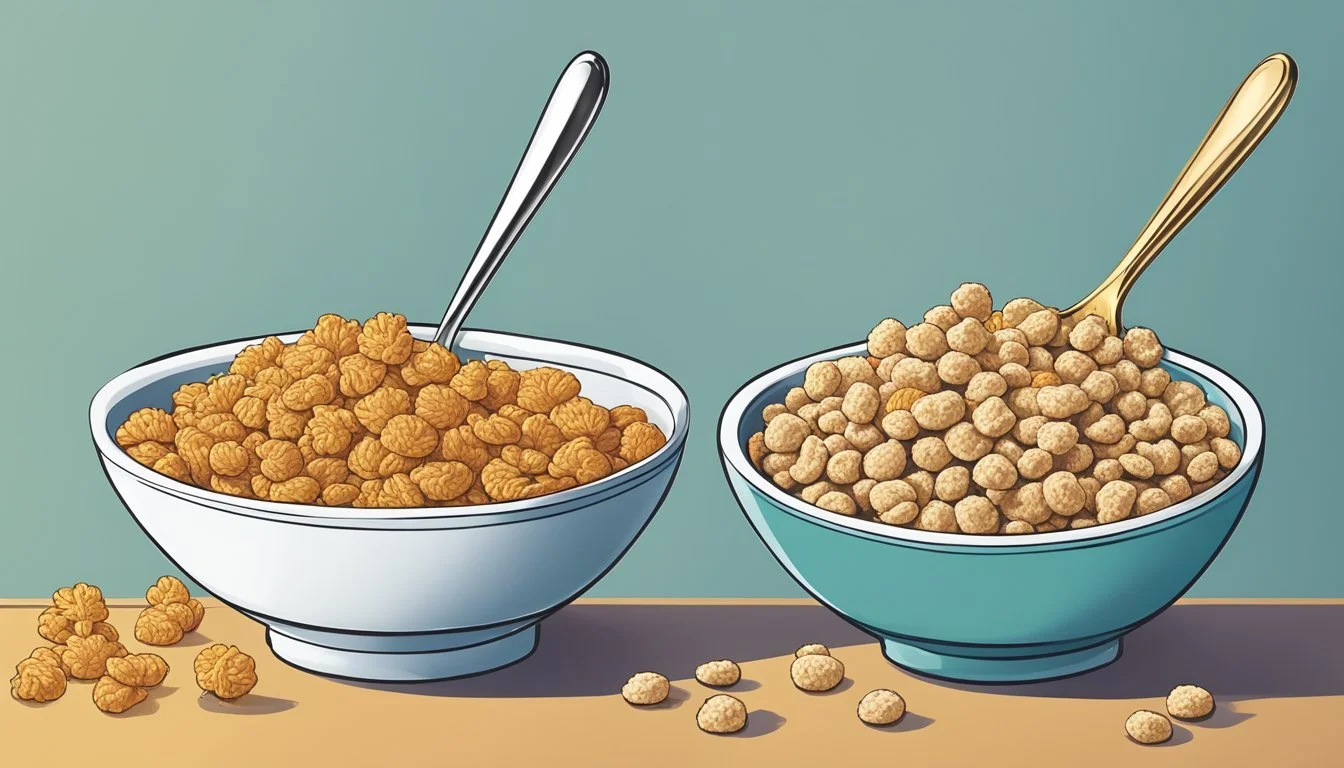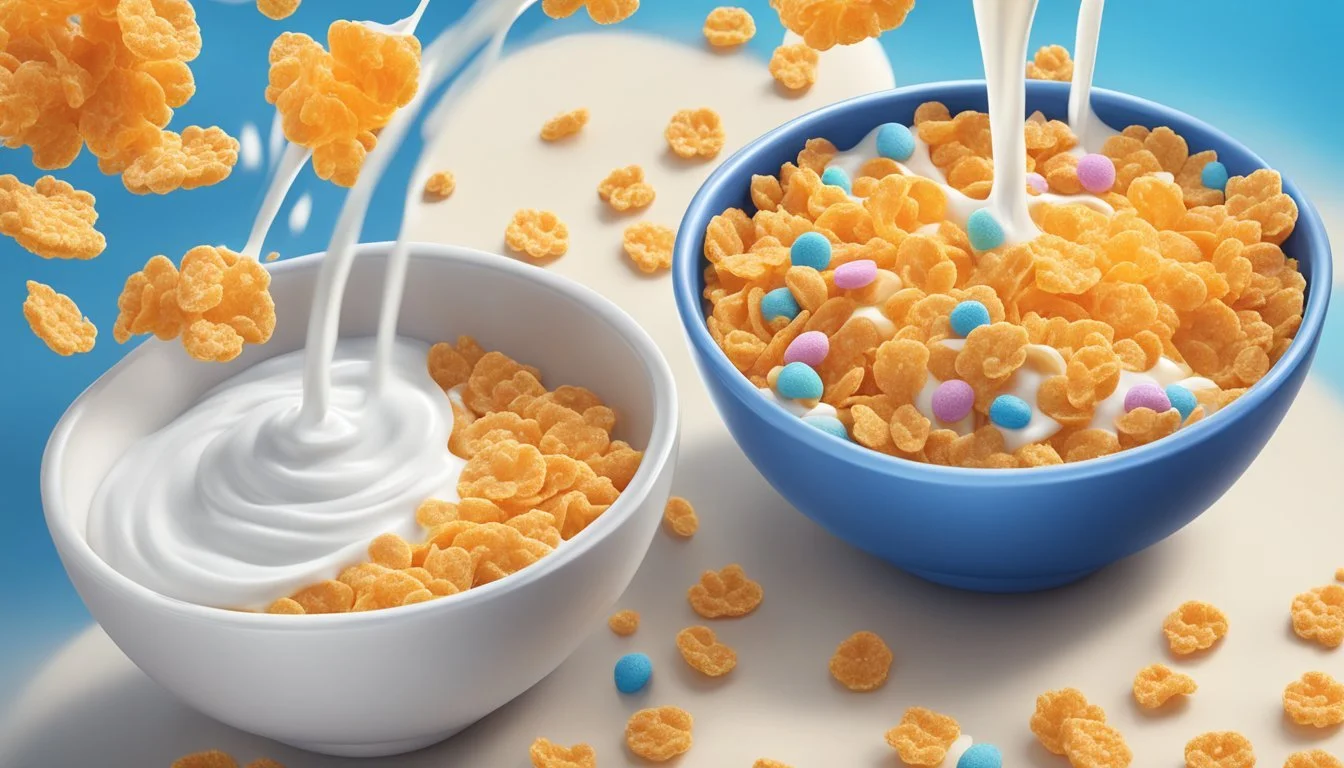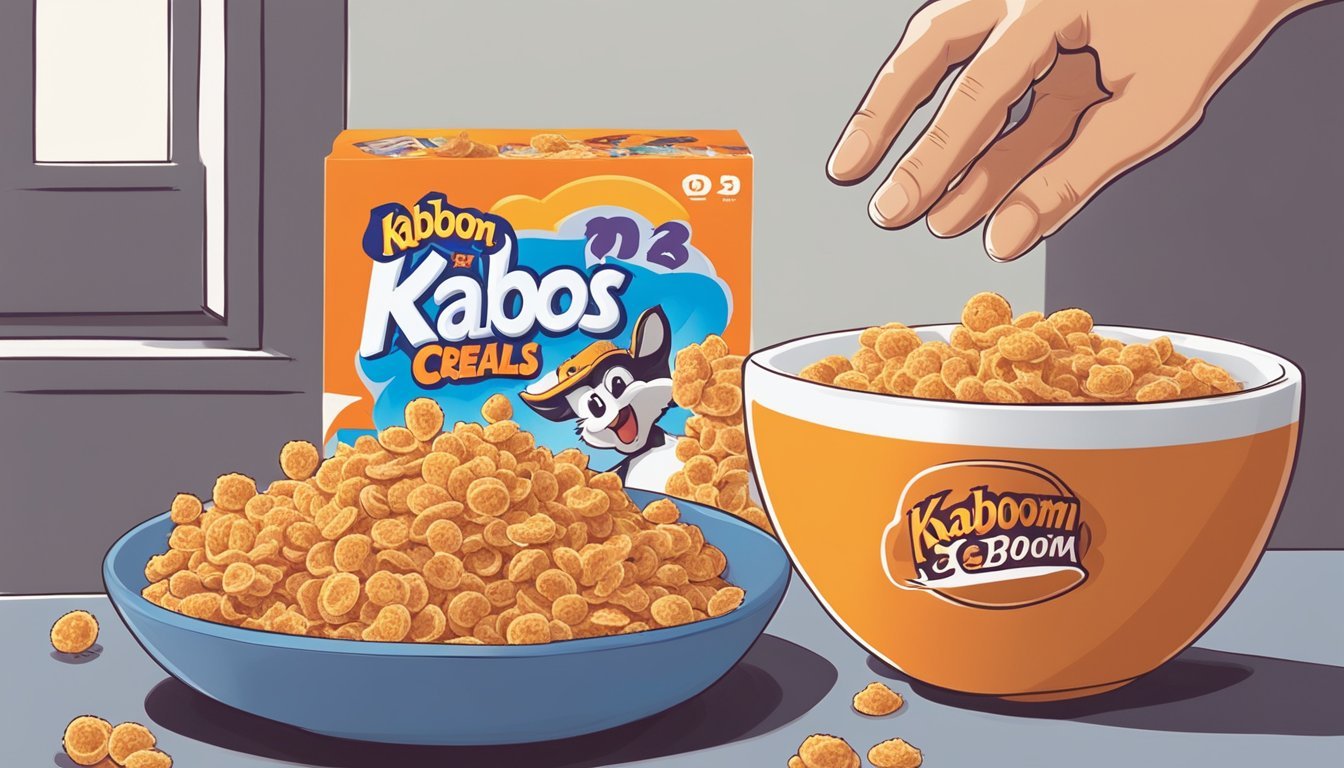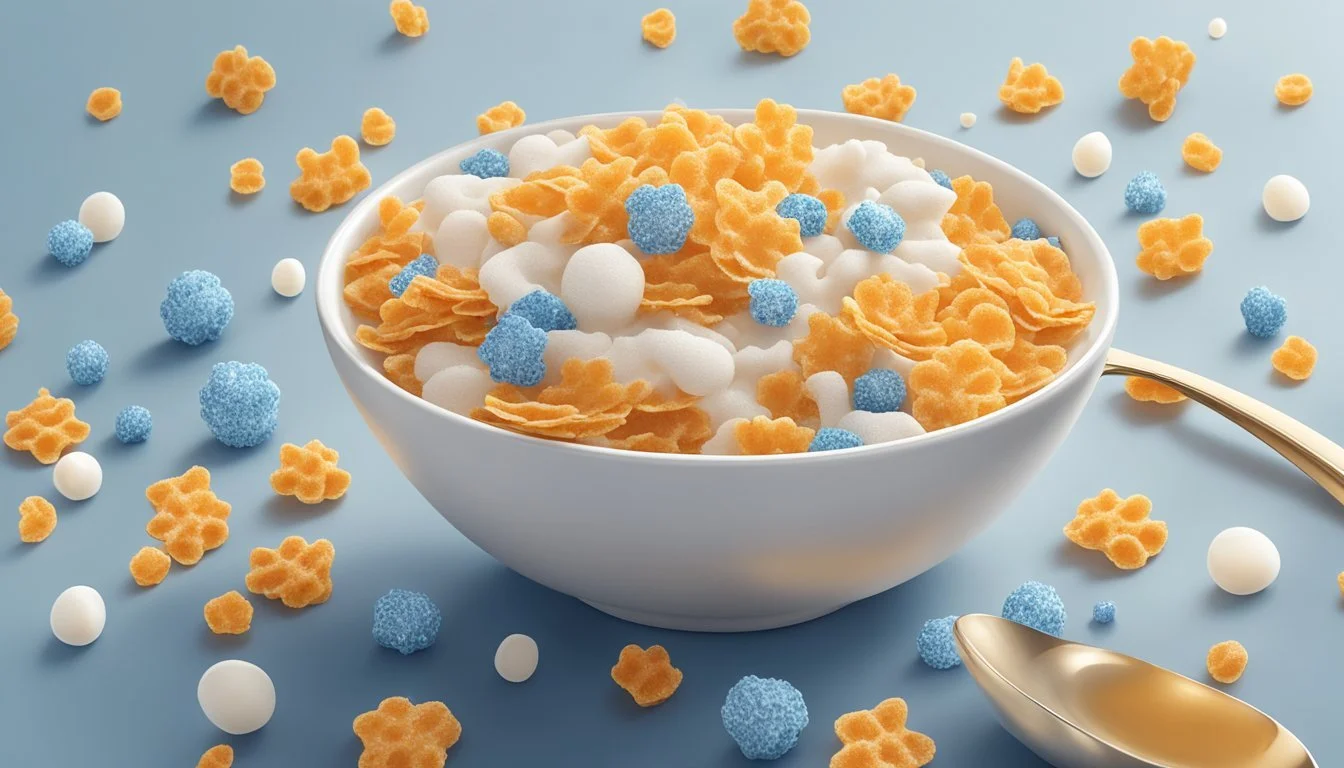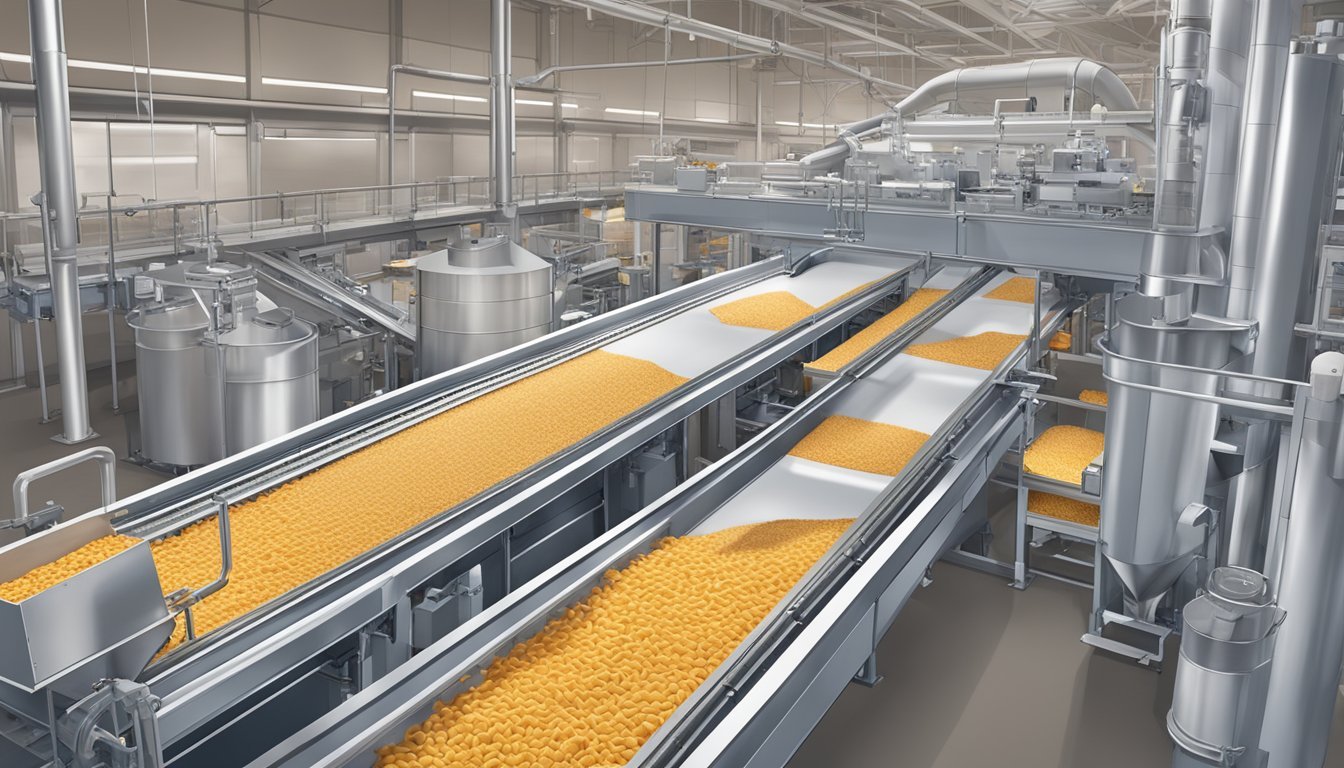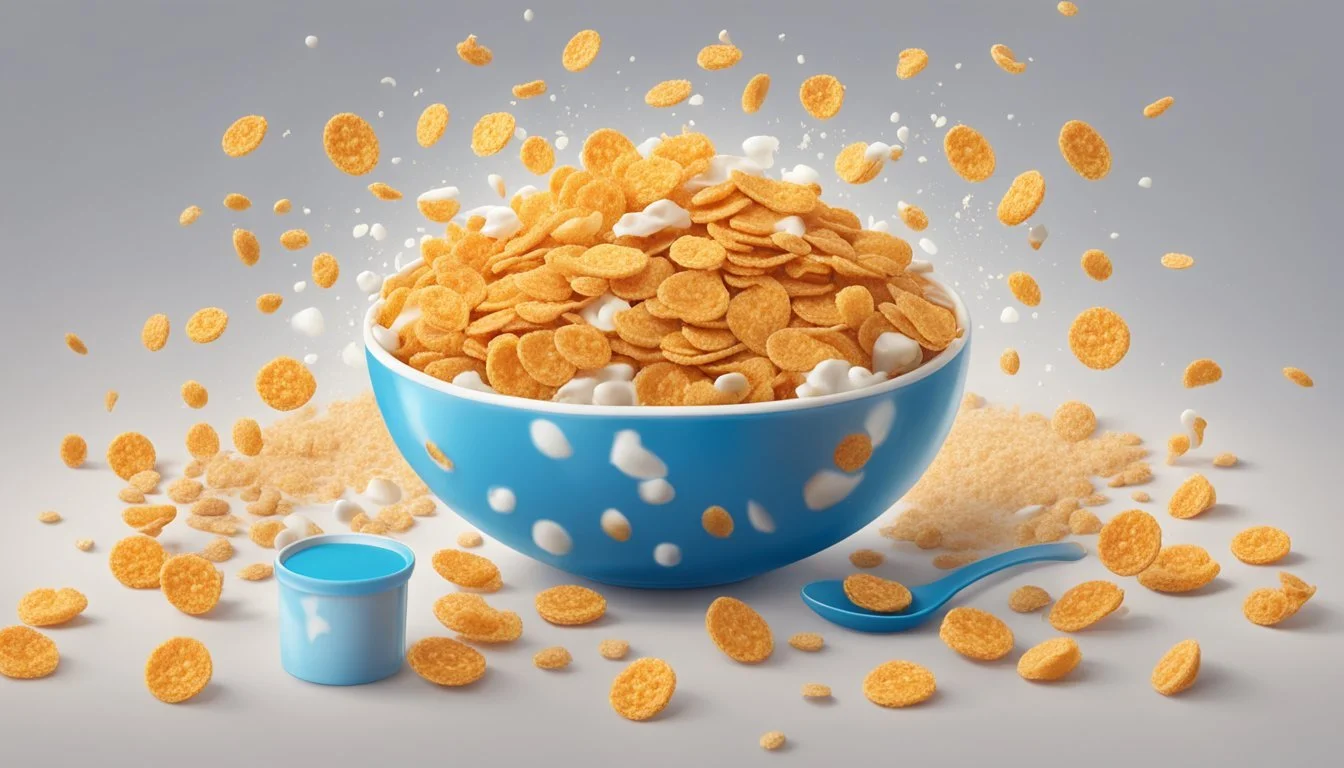Frosted Flakes vs Kaboom
Comparing Breakfast Cereal Choices
This Article is Part of Our Breakfast Cereal Guide with Details on Frosted Flakes Nutrition and Kaboom Nutrition
When it comes to breakfast cereals, the debate between Frosted Flakes and Kaboom often arises among cereal enthusiasts. Frosted Flakes, introduced by Kellogg's in 1952, has become a staple in many households due to its crispy texture and sugary coating that appeals to both kids and adults. This classic cereal is renowned for its consistency and the iconic mascot, Tony the Tiger, who has made it a recognizable brand across grocery store shelves.
Kaboom, on the other hand, offers a different experience with its vibrant, colorful rings and addition of marshmallows. Though it might not have the same household name recognition as Frosted Flakes, Kaboom has its own unique appeal. Its combination of flavors and playful presentation often attracts a younger audience looking for an exciting start to their day.
In comparing these two cereals, it's clear that each has its distinct strengths. Frosted Flakes provides a straightforward, sweet crunch, while Kaboom offers a more whimsical and varied taste experience. Exploring the characteristics of both cereals can help readers decide which one to pick up on their next grocery store trip.
Historical Background
Both Frosted Flakes and Kaboom are iconic breakfast cereals that made significant impacts in their respective markets. Each brand brought distinctive flavors and concepts, appealing to different demographics and preferences.
Origin of Frosted Flakes
Frosted Flakes was introduced by Kellogg's in 1952. Originally known as Sugar Frosted Flakes, this cereal was a sweetened adaptation of the company's traditional Corn Flakes.
By 1983, "Sugar" was dropped from the name to modernize the brand. The cereal quickly became popular, partly due to its mascot Tony the Tiger. Tony, with his catchphrase "They're Grrreat!", became an iconic figure, enhancing brand recognition and appeal. Frosted Flakes targeted children and families, ensuring a strong foothold in the competitive cereal market.
Kaboom's Entry into the Market
Kaboom, a different kind of cereal, was introduced by General Mills in the late 1960s. Unlike Frosted Flakes, Kaboom was known for its multicolored, circus-themed shapes and sugary coating.
The cereal featured a clown mascot, catching the eyes of younger consumers with its vibrant packaging. It distinguished itself with an emphasis on fun and excitement at breakfast time, making it stand out among other offerings like Cheerios. While not as enduringly prominent as Frosted Flakes, Kaboom carved out its niche before being discontinued in the 2010s.
Comparative Analysis
Frosted Flakes and Kaboom cereals offer distinct experiences in terms of flavor, nutritional content, and texture. Each has unique attributes that cater to different preferences and dietary needs.
Flavor Profiles
Frosted Flakes bursts with a sweet and citrusy flavor, reminiscent of its cereal namesake. The sweetness is balanced with a slight zest, making it a favorite among those with a sweet tooth.
Kaboom, on the other hand, combines a fruity blend with hints of berry and citrus. The flavor is more complex and offers a varied taste experience.
Both cereals provide a pleasant taste, though Frosted Flakes leans more towards simplicity while Kaboom offers a multifaceted flavor profile.
Nutritional Content
Frosted Flakes contains higher sugar content, making it less ideal for those monitoring sugar intake. The typical serving size offers modest amounts of fiber but is higher in sugars. It contains essential vitamins and minerals but lacks significant protein and healthy fats.
Kaboom provides a more balanced nutrition profile. It offers moderate amounts of sugars and fiber. The inclusion of protein and healthy fats makes it a slightly more nutritious option. Kaboom is also fortified with a broader range of vitamins and minerals, appealing to those seeking a nutrient-rich breakfast.
Texture and Quality
Frosted Flakes boasts a crisp and fresh texture. The frosty exterior provides a satisfying crunch that remains consistent even after being milked for a few minutes. This makes it a go-to for those who enjoy a crunchy cereal experience.
Kaboom has a softer texture with a bit of chewiness. The varying shapes and sizes of the pieces contribute to a unique mouthfeel. Quality-wise, both cereals maintain a high standard, though the experience of eating them can differ significantly based on personal preferences. Those who prefer a softer cereal might lean towards Kaboom, while crunch lovers will likely prefer Frosted Flakes.
Market Presence
Frosted Flakes and Kaboom have both established notable market footprints. They use distinct mascots and robust advertising campaigns to capture consumer attention and generate brand loyalty.
Brand Recognition
Frosted Flakes, produced by Kellogg's, has a strong brand presence thanks to its iconic mascot, Tony the Tiger. Introduced in 1952, Tony has become a household name, significantly boosting the cereal's popularity.
Kaboom, on the other hand, was launched by General Mills in 1969. Its colorful clown mascot helped the brand to stand out initially, but it never achieved the same level of mainstream recognition as Frosted Flakes.
Frosted Flakes is recognized for its distinctive taste and packaging. In contrast, Kaboom's presence has waned over years, largely due to less aggressive branding and fewer product innovations.
Advertising Campaigns
Frosted Flakes has enjoyed decades of success owing to its memorable advertisements. Tony the Tiger's "They're Grrrrreat!" catchphrase, voiced by Thurl Ravenscroft, was particularly effective. These efficient marketing strategies played a crucial role in securing its position as a top cereal brand.
Kaboom's advertising has been less persistent and far-reaching. While their commercials in the 1970s and 1980s featured the clown mascot and bright, cheerful animation, they lacked the consistency and broad appeal seen in Frosted Flakes campaigns.
Kellogg's continued investment in high-profile advertising maintains Frosted Flakes' relevance. General Mills' reduced promotional efforts for Kaboom have led to its decline in the competitive breakfast cereal market.
Consumer Preferences
Consumers show distinct patterns in their preferences for Frosted Flakes and Kaboom cereals. Key differences emerge in their purchasing habits and the way these cereals influence their daily routines.
Sales Trends
Kellogg's Frosted Flakes consistently outperforms Kaboom in sales. This popular cereal is favored for its sweet taste and ability to retain crispiness in milk. Despite its higher price, many shoppers are willing to pay extra for the familiar flavor and texture.
Kaboom, produced by General Mills, targets a niche market with its child-friendly appeal and vitamin-enriched formula. Sales tend to spike in areas with a higher concentration of young families, though grocery stores generally report lower overall sales compared to Frosted Flakes.
Cultural Impact
Frosted Flakes has a strong cultural presence, thanks to its long history dating back to 1952. Tony the Tiger, its iconic mascot, resonates with multiple generations, often appearing in morning routines and advertisements. This cultural staple reinforces brand loyalty and influences consumer choices.
Kaboom, though less prevalent, has its own unique footprint. Known for its colorful shapes and playful branding, it often attracts attention for its fun breakfast experience. While Kaboom may not dominate the market, its distinctive appeal and nutritious image make it a memorable choice for some families.
Product Variants
When comparing Frosted Flakes to Kaboom, it is essential to explore their product varieties. Frosted Flakes have expanded into several interesting flavors and variants, while Kaboom has also curated unique taste options.
Frosted Flakes Varieties
Kellogg's has introduced a diverse range of Frosted Flakes variants to cater to different taste preferences. Traditional Frosted Flakes remain a classic choice.
For those who prefer chocolate, Cocoa Frosted Flakes offer a rich, cocoa-infused taste. There's also Banana Frosted Flakes, blending the sweetness of bananas with the crunchy cereal.
Kellogg's celebrates special occasions with Birthday Confetti Frosted Flakes, featuring colorful sprinkles and a fun twist on the original. Additionally, fans of cinnamon can enjoy the spices of Cinnamon Frosted Flakes. Each variant provides a unique flavor experience, while retaining the familiar crunch.
Kaboom's Flavor Line-up
Kaboom cereal may not have as many variants as Frosted Flakes, but it differentiates itself with bold and vibrant flavors. Kaboom, known for its colorful star-shaped and smiley face marshmallows, offers a delightful sweetness that appeals to children.
The primary flavor of Kaboom is a fruity mix that can be likened to Fruity Pebbles, offering a burst of fruitiness with every bite.
Although it doesn't match the numerous spin-offs seen in Frosted Flakes, Kaboom keeps it simple with its signature, engaging flavor that has maintained a steady fan base over the years. This fruity, marshmallow-studded cereal provides a nostalgic and enjoyable breakfast option.
Health Impact and Nutrition
When comparing Frosted Flakes and Kaboom cereals, it's important to examine their sugar content, caloric values, and the essential vitamins and minerals they offer. Both cereals offer different nutritional benefits and drawbacks.
Sugar and Caloric Content
Frosted Flakes contains 10-15 grams of sugar per serving, contributing to its sweet taste. Each serving provides around 110-114 calories. This high sugar content can be a concern for those monitoring their sugar intake, particularly for children. In contrast, Kaboom cereal typically contains comparable sugar levels and similar calorie counts.
A diet high in sugar can lead to various health issues, such as increased risk of obesity and dental problems. Therefore, consumers must be mindful of their daily sugar intake when choosing between these cereals.
Cereal Sugar per serving Calories per serving Frosted Flakes 10-15 grams 110-114 calories Kaboom Similar amount Similar amount
Micronutrients and Dietary Fiber
Frosted Flakes is fortified with several vitamins and minerals, including iron, thiamine, folic acid, vitamin B6, and vitamin D. These contribute substantially to daily nutritional needs, such as 45% of iron and 30% of thiamine requirements per serving.
Kaboom cereal, now discontinued, was also known for its fortified nutrients, providing essential vitamins like calcium, vitamin D, and potassium.
Dietary fiber in both cereals is quite low, with Frosted Flakes offering around 0.6-1 grams per serving. Low fiber content can lead to digestive issues and reduced long-term health benefits. Incorporating other fiber-rich foods is advisable to balance the diet effectively.
In summary, while both cereals are rich in essential vitamins and minerals, they are also high in sugar and low in fiber. Consumers should balance their diet accordingly, considering these nutritional profiles.
Consumer Insight
Consumer preferences and feedback can provide significant insight into the reception and performance of both Kellogg's Frosted Flakes and Kaboom cleaning products.
Demographic Preferences
Different demographics show varied preferences when it comes to breakfast cereals and cleaning products. Frosted Flakes, for example, enjoys widespread popularity among children and teenagers due to its sweet flavor and crunchy texture. Parents often choose it because it's a quick breakfast option that appeals to their kids.
Health-conscious adults, meanwhile, may be more selective, often opting for brands with lower sugar content. Frosted Flakes’ high sugar content might deter some, despite its nostalgic appeal.
In contrast, Kaboom's cleaning products tend to attract a primarily adult demographic. Busy professionals and parents lean towards its effective bathroom sprays and toilet cleaners. Their wide range appeals to those seeking convenient and efficient cleaning solutions.
Consumer Feedback
Feedback for Frosted Flakes typically highlights the cereal's taste and texture. Many reviews praise its consistent crunchiness, even when soaked in milk, and its sweet flavor that entices young consumers.
However, some consumers have raised concerns about the high sugar content. There are also occasional comparisons with store-brand alternatives which are sometimes deemed more cost-effective without compromising too much on taste.
Kaboom products receive high ratings for their cleaning efficacy. Users particularly commend the Kaboom Foam-Tastic for its ability to remove tough bathroom stains effortlessly. The foam application makes it easy to use and less messy, a feature highlighted in numerous positive reviews.
Despite its effectiveness, some consumers express dissatisfaction with the chemical smell of Kaboom products. Balancing effectiveness and a pleasant scent remains a recurring theme in user feedback.
Production and Manufacturing
The production and manufacturing of Frosted Flakes and Kaboom involve various stages, beginning with the sourcing of primary ingredients and leading up to the final packaging of the cereals. Each brand employs distinct processes and materials to achieve their unique textures and flavors.
Materials and Ingredients
Frosted Flakes primarily use milled corn as the base ingredient. They are flavored with malt flavor and coated with sugar to create their signature taste.
Kaboom cereal, produced by General Mills, includes a different mix of grains like oat flour alongside corn. Both cereals include added vitamins and minerals to enhance nutritional value.
Artificial flavors and colorings are more prominent in Kaboom to achieve its vibrant appearance, whereas Frosted Flakes rely more on their subtle sweetness.
Manufacturing Process
Kellogg's manufactures Frosted Flakes through a multi-step process. First, the milled corn is cooked under high-pressure steam. It is then rolled into thin flakes and toasted. After toasting, the flakes are coated with sugar and malt flavor, and finally dried to achieve crispness.
Kaboom's manufacturing by General Mills involves combining corn, oat flour, and other ingredients. The mixture is extruded into various shapes, then baked. Post-baking, the cereal pieces are sprayed with vitamins, minerals, and sweeteners.
These steps ensure both cereals maintain their distinctive textures and flavors while retaining nutrient content.
Market Alternatives
The cereal market offers various alternatives to traditional brands like Frosted Flakes and Kaboom. Below, these alternatives are explored in the context of store brands and health-conscious options.
Comparing Store Brands
Store brands such as Walmart's Great Value and Target's Market Pantry provide cost-effective alternatives to name-brand cereals. For instance, Great Value Frosted Flakes are a common substitute for Kellogg's Frosted Flakes, though they generally have a different texture and flavor profile. Consumers often find store brands have a denser, less crisp texture.
EnviroKidz Amazon Lightly Frosted Flakes also serve as an alternative, made with organic ingredients and reduced cane juice instead of sugar. Comparing flavors, store brands often focus more on budget and less on premium ingredients.
Generic versions of other popular cereals like Lucky Charms, Rice Krispies, and Cinnamon Toast Crunch can also be found in most supermarket aisles. These off-brand options typically mimic the appearance and taste of their name-brand counterparts but may fall short in areas such as flavor depth and texture.
Rise of Health-Conscious Cereals
Another section of the market focuses on health-conscious consumers. Products from brands like Nature's Path and Magic Spoon are leading the charge in this category. Magic Spoon offers cereal with high protein content and zero sugar, catering to those looking for healthier choices without sacrificing flavor.
General Mills has also responded with versions like Organic Cinnamon Toast Crunch, which features fewer artificial ingredients. Additionally, Malt-O-Meal is known for producing cereals that emphasize whole grains and reduced sugar.
These health-oriented alternatives often avoid preservatives, artificial flavors, and colors, appealing to parents and individuals aiming for healthier diets. Ingredients like organic corn and natural sweeteners are more common in these products, differentiating them from traditional sugar-laden options.
Advertising and Branding
The advertising and branding of Frosted Flakes and Kaboom have played significant roles in their market positions, with impactful mascots and strategic marketing campaigns shaping consumer perception and brand loyalty.
Evolution of Mascots
Frosted Flakes has been strongly associated with Tony the Tiger, a mascot created in 1952. Tony the Tiger, voiced by several actors including Lee Marshall, symbolizes strength and confidence. His slogan, “They’re grrreat!” reinforces the brand’s energetic image. The introduction of Tony Jr. in later years added a youthful touch to the brand, appealing to younger consumers.
On the other hand, Kaboom leveraged a vibrant clown mascot. This character was designed to be colorful and engaging, aligning with the cereal’s fun and playful brand persona. Though not as long-lasting or iconic as Tony the Tiger, the Kaboom clown helped establish a unique identity in the competitive cereal market in its time.
Impacts of Marketing
Frosted Flakes employed multi-channel marketing strategies, including television commercials, print ads, and sports sponsorships. Tony the Tiger’s presence in these mediums helped in reinforcing brand attributes of energy and fun. The use of slogans and vibrant imagery in advertisements tapped into the emotional and aspirational desires of children and parents alike.
Meanwhile, Kaboom’s marketing leaned heavily on its playful and colorful advertisements, with a focus on appealing directly to kids. Though it did not achieve the same level of brand longevity as Frosted Flakes, its marketing created memorable connections with its target audience. Kaboom campaigns often featured both the cereal and the clown mascot engaging in playful adventures, thereby embedding the product in the minds of children through visual storytelling.
Cultural and Legal Issues
The popularity and legal status of cereals like Frosted Flakes and Kaboom vary across different countries. Notably, the ingredients and branding can lead to significant cultural and legal differences globally.
Trademarks and Copyright
Frosted Flakes and Kaboom, both widely recognized brands, have built their identities through unique trademarks. For example, Frosted Flakes is associated with Tony the Tiger, a distinctive mascot enhancing its brand recognition. Trademarks protect these mascots and logos from unauthorized use, ensuring brand consistency.
In the UK, Australia, and Brazil, trademarks play an essential role in maintaining product identity and consumer trust. These countries have strict trademark laws that protect brands like Frosted Flakes from knock-offs and imitators. Some countries have even stricter regulations, where certain chemicals used in food products, including those in Frosted Flakes, lead to the cereal’s ban due to health concerns.
Cereal's Place in Pop Culture
Both Frosted Flakes and Kaboom have left a significant mark on pop culture. Frosted Flakes is famous for its catchphrase "They're Gr-r-reat!" and has appeared in numerous commercials and parodies. Its branding is often intertwined with childhood nostalgia, making it a staple in American homes for decades.
Kaboom, on the other hand, featured colorful mascots inspired by classic children’s characters like Pinocchio, Cinderella, and Mary Poppins. This nostalgic branding connected with children and adults alike, embedding the cereal in the cultural fabric.
Pop culture references include television shows and movies, enhancing the cereals’ legacy. The nostalgic appeal remains strong, especially with vintage advertising campaigns and memorabilia that celebrate these iconic brands.
Global Market Dynamics
Frosted Flakes and Kaboom have distinct positions in various global markets, with specific trends influencing their performance in different regions. This section examines key regional dynamics and comparative market analyses to highlight unique market behaviors.
North America versus International
In North America, Kellogg's Frosted Flakes dominate the market. They benefit from strong brand loyalty and extensive distribution networks. Consumers in the US and Canada prefer the sweet, crunchy texture, which suits their breakfast habits.
Kaboom, though less prevalent, has carved a niche among families seeking fun, colorful cereals.
Internationally, Frosted Flakes see varied success. In the UK and Australia, for instance, they compete with local brands and new entrants emphasizing health benefits. Markets like Japan prefer varieties with lower sugar content, adapting to local dietary preferences. Brazil’s market exhibits growing demand for affordable store brands, adding stiff competition for Kellogg's.
Comparative Market Analysis
Kellogg's Frosted Flakes leverage their strong brand name and aggressive marketing strategies to maintain a competitive edge. The cereal’s international adaptations, such as reduced sugar versions for certain markets, illustrate Kellogg's responsiveness to regional consumer demands.
Comparatively, Kaboom’s market strategy focuses on unique, colorful designs that appeal to younger consumers. Although not as entrenched as Frosted Flakes, Kaboom attracts a specific demographic, aiding its gradual market penetration.
A notable contrast exists between the two in terms of market segmentation. Frosted Flakes command higher prices, positioning them as a premium product. Kaboom, often perceived as a novelty, is priced more competitively, targeting a broader audience.
By understanding these dynamics, one can discern the factors driving the performance of both cereals across different geographies.
Final Remarks
Frosted Flakes and Kaboom offer distinct experiences in taste, nutrition, and market trends. These insights will help consumers make informed choices regarding health benefits and flavor preferences.
Future Trends in Breakfast Cereals
The breakfast cereal market is evolving with consumer preferences shifting towards healthier options. Frosted Flakes has been a staple since 1951 and remains popular due to its sugary taste and simple ingredients. However, there is a growing demand for cereals with reduced sugar and added nutrients.
Kaboom, although discontinued, represents an era when colorful and vitamin-enriched cereals were in vogue. The trends today are moving towards organic ingredients, non-GMO products, and cereals that cater to dietary restrictions such as gluten-free and vegan options. This shift is likely to influence future product development. As consumers become more health-conscious, cereals with high fiber, protein, and lower sugar content are expected to dominate shelves.
Recommendations for Consumers
Consumers seeking a nostalgic and flavorful cereal would still gravitate towards Frosted Flakes for its sweetness and crunch in milk. It's important to balance this choice with nutritional needs. While Frosted Flakes provides essential vitamins, its high sugar content can be a drawback for those monitoring their diet.
For a healthier breakfast, consider cereals that blend taste and nutrition. Look for options rich in vitamins like B12, B3, and iron, reminiscent of Kaboom’s original formula but with modern health standards.
Incorporate fresh fruits or almond milk to enhance the nutritional profile. Comparing labels is crucial in identifying cereals that meet both flavor preferences and health requirements. Exploring newer brands that offer higher fiber and protein can provide more balanced and satisfying breakfast choices.

